1. Cheena Vala "Chinese Fishing nets". My attempt to find images of nets in modern-day china that are similar to the ones in cochin proved fruitless, but I did find pictures of nets in vietnam and cambodia that look like the cochin nets and appear to be referred to in those countries as being from china. As Ammini Ramachandran of peppertrail.com says, some of the fishermen who man the nets in cochin, wear east-asian-looking conical hats.

Fishing Nets, Kochi, India |

Fishing Nets, Chau Doc, Vietnam
|
2. Cheena Chatti "Chinese Pot" a.k.a a Wok. This is an essential tool in the making of Appams (described by Madhur Jaffrey to be a "cross between a french crepe and an english muffin") --- one of my favourite foods and one that far too few people know about. You need the hemispherical wok to swirl the batter to create the spongy (muffin-like) center and crisp (crepe-like) outer ring of the appam.
 3. Cheena Bharani "(Large) Chinese vessel". Although I don't recall seeing one, they are apparently used widely in the "production & storage of 'Uppu Manga', a method of utilising ripe mangoes for long term use as a curry" [according to my uncle Ninan]. Here's a picture of one that I found courtesy of Binu Mathew's
page of photos.
3. Cheena Bharani "(Large) Chinese vessel". Although I don't recall seeing one, they are apparently used widely in the "production & storage of 'Uppu Manga', a method of utilising ripe mangoes for long term use as a curry" [according to my uncle Ninan]. Here's a picture of one that I found courtesy of Binu Mathew's
page of photos.
4. Porcelain : I haven't seen any myself but, according to the peppertrail.com article, there is old Chinese blue and white porcelain to be found in houses and antique shops in Kerala that is a legacy of trade with China.
Levathes' book talks about the factories that were set up in China to produce large quantities of porcelain for export and says that "ample quantities of chinese porcelains have been found from the Philippines to East Africa".
5. Elaborate Sloping Roofs :My grand-uncle George pointed out the similarity between roofing in traditional homes in Kerala and East Asia. While this might be a function of similar environments generating similar artifacts, I think it is remarkable that temples in Kerala have the multiple-layered, sloping roofs that are so similar to temples in east asia but so different from temples in neighbouring regions (like Tamilnadu, which have tall stone gopurams).

Vadakumnathan temple, Thrishoor, Kerala |

Buddhist Temple, Kyoto, Japan
|
6. Boats : This is also questionable, but
some claim that the similarity of the river-boats of Kerala (vallams) to the river-boats of East Asia (sampans?) is also a legacy of the Chinese cultural interaction. I report you decide :

Vallam, Kerala (courtesy Raghu Ramachandran) |

Sampan, China (courtesy darrellpeck.com)
|
7. Martial Arts : Some martial arts websites refer to Kalaripayattu, the traditional martial art of Kerala, as the mother of all martial arts.
One controversial theory (proposed not just by wishful chauvinistic Indians, but by some East Asian sources as well) is that in 520 AD the Buddhist monk Boddhidharma travelled from South India (presumably Kerala) to the Shao Lin monastery in China and taught the monks there the martial-art that later became Kung Fu. There is really very little evidence to support this story, and as the wikipedia page indicates, many disagree with this theory, but it would be nice if true.

Kalaripayattu |

Kung Fu
|














